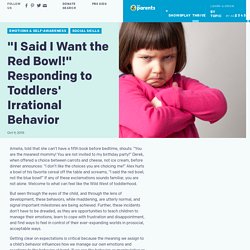

Five essential tips for teaching very young children English. Are you daunted by the prospect of teaching English to very young children? Sheona Gilmour, lead educator on our new online course for teachers and parents, offers a few tips. Teaching English to very young children can be challenging, especially if you haven't done any training for the early years classroom. The first time I walked into a kindergarten, I didn’t want to go back the next day. I came from a background of teaching older children, who sat at desks and whose attention I could hold more easily. So the new environment, full of young children with much shorter attention spans, felt overwhelming. But if you take on board a few essentials, there's a good chance you'll end up cherishing the experience. 1.
It is vital to get the approach right for children of this age. You need to understand what to expect from the children and make sure that what you do in class reflects where they are in their development. Pre-birth to Three: Observation, Assessment and Planning. Poems for kids. 50+ Quick & Easy Kids Crafts that ANYONE Can Make! Songs for kids. How to teach children English using illustrated storybooks.
What makes illustrated storybooks such a good resource for teaching young learners of English? The British Council’s Gail Ellis, co-author of a storytelling handbook for primary English language teachers, explains. Listen to an interview with Gail in our podcast and register for her webinar taking place on Thursday, 2 October. Nihms175063. The Art of Control. Executive function — our ability to remember and use what we know, defeat our unproductive impulses, and switch gears and adjust to new demands — is increasingly understood as a key element not just of learning but of lifelong success.
Researchers at the Center on the Developing Child at Harvard University describe executive function as an air traffic control system for the mind — helping us manage streams of information, revise plans, stay organized, filter out distractions, cope with stress, and make healthy decisions. Children learn these skills first from their parents, through reliable routines, meaningful and responsive interactions, and play that focuses attention and stirs the beginnings of self-control.
But when home is not stable, or in situations of neglect or abuse, executive function skills may be impaired, or may not develop at all, limiting a child’s success in elementary school and later life. Imaginary Play Support it by: Storytelling “Children love to tell stories. How to help your child learn English with YouTube videos.
Tracey Chapelton, education consultant and materials writer, has some advice for parents of young English learners, whose home language might not be English. To learn a language we need a lot of exposure to it. YouTube is beneficial if you are not a fluent English speaker, and want a more fluent model of English for your child. Helped along by the visuals of their favourite cartoon, children can watch their favourite characters involved in adventures, while absorbing the language.
Repetition is also important for language learning. It helps us remember important words and expressions. The more they watch, the more they will understand, eventually using the language themselves. Learning Time with Timmy. Practical tips.
By Opal Dunn, educational consultant and author Introduction Young children learn English differently from most adults.

Most have an innate ability to pick up English while taking part in activities, by making sense of what they are doing and picking up the adult’s language that accompanies the activity. Learning_through_play_ey. Sound Words: Examples of Onomatopoeia. Onomatopoeia is a fun, linguistic tool used in literature, songs and advertisements. Now that you've seen examples of the individual words, consider the following examples of onomatopoeia words in use. Take a look at the different onomatopoeia examples in Todd Rundgren's song, appropriately named Onomatopoeia. Effective Teacher-Child Interactions. The Brain-Changing Power of Conversation.
The Science Researchers used highly faithful audio recorders — a system called Language Environment Analysis (known as LENA) — to capture every word spoken or heard by 36 4–6 year olds from various socioeconomic backgrounds over two full days. MIT Brain Study: Back-And-Forth Talk Key To Developing Kids' Verbal Skills. New MIT research finds that for children's brain development, parents don't just need to talk to their kids — it's important to talk with them, in back-and-forth exchanges. "What we found is, the more often parents engaged in back-and-forth conversation with their child, the stronger was the brain response in the front of the brain to language," said cognitive neuroscience professor John Gabrieli.
Story continues below Most Viewed Stories That stronger brain response, measured as children ages 4 to 6 lay in a scanner listening to simple stories, reflects a deeper, more intimate engagement with language, said graduate student Rachel Romeo. On average, a child from a better-off, more-educated family is likely to hear 30 million more words in the first three years of life than a child from a less-well-off family. Get personal health and local medical research news sent to your inbox each week. That finding from 1995 helped explain some school achievement gaps. Carol Dweck: The power of believing that you can improve. How can parents and teachers best educate young children?
What principles can both teachers and parents bring to the education of very young children? Gillian Craig, who was part of the Learning Time with Shaun and Timmy writing team, explains. As teachers and parents, we follow certain principles in our roles. Often though, these principles overlap and all we need to do is recognise and reinforce these areas. Ask (the right) questions. Listening Skills for Staff. A longitudinal investigation of the role of quantity and quality of child-directed speech in vocabulary development. Low-cost play ideas: video. Surprisingly Simple Techniques for Challenging Behaviour - Kathy Brodie Early Years Training.
I often get asked about children’s behaviour. It is a massive topic, with many facets. However, I would always start from the perspective that all behaviour, good or unacceptable, is a form of communication. It is how we, as practitioners and adults, respond to that communication that makes all the difference. The Webster Stratton method is a well known and widely used behaviour management strategy. Schema and Fairies - Kathy Brodie Early Years Training. Schemas are one of those things that divide practitioners, like fairies at the bottom of the garden.
You either believe in them and are in absolute awe at how amazing they are, or you just don’t believe they exist. Schemas in Children’s Play. Written by Clare CaroSchemas in Children’s Play are such an important concept when it comes to the development of our children that it’s worth taking the time to understand them so you can facilitate them when you see them.What are these schemas?

Well it’s really a fancy word for the urges that children have to do things like climb, throw things and hide in small places. They appear through play; perhaps it is the way they choose to do things, or what they desperately need to do out of the blue! Bringing It All TogetherAfter looking at each schema individually to get to grips with what each 'urge' is all about we may already be able to recognise some of the different ways they can appear in your child.Rotation, Trajectory, Enveloping, Orientation, Positioning, Connection, Enclosure/Container, Transporting and Transformation are urges that show in all children starting as early as their first birthday, some times before.How Can Knowing About These Urges Help Us?
"I Said I Want the Red Bowl!" Responding to… Amelia, told that she can’t have a fifth book before bedtime, shouts: “You are the meanest mommy!

You are not invited to my birthday party!” Derek, when offered a choice between carrots and cheese, not ice cream, before dinner announces: “I don’t like the choices you are choicing me!” Alex hurls a bowl of his favorite cereal off the table and screams, “I said the red bowl, not the blue bowl!” Does my toddler have a short attention span because she won’t sit still for a story? A: It is perfectly normal for toddlers to not sit still very long—period.

Most don’t like to stay in one place for long now that they can explore in so many new ways—by running, jumping, and climbing. So, an adult’s idea of snuggling on the couch to hear a story may not be the same idea a toddler has for story-time. You may only be able to read or talk about a few pages in a book at a time. FAQ: Raising Bilingual Children. Why want bilingual children? There are many reasons, but the two most common are: 1) The parents speak different languages (say, an American woman and a Turkish man). 2) The parents speak the same language, but live in a community where most people speak something else (say, a Korean couple living in the USA).
In the first case, both the mother and father may want to be able to use their own language when talking to their children. This is the bilingual home situation. 9 Things You Need to Know About Play (and Preventing Challenging Behavior!) — Challenging Behavior. Moodle. Moodle. Moodle. Deconstructing Role Play – Provide the Resources, Step Back and Watch Children’s Learning Flourish. Symbolic play and language development. 1. Introduction 1.1. Choice page. The cognitive benefits of play: Effects on the learning brain. Low-cost play ideas: video. Primary school shake-up to focus on ‘play-led’ learning.
Children at primary schools would not study traditional subjects until as late as 10 years of age, under proposals being considered by policymakers. Why Movement is Essential in Early Childhood. Play to Learn: Discussion. Play to Learn. Why play-based learning? (free article) - Early Childhood Australia.
Convention on the Rights of the Child. Arabic | Chinese | French | Russian | Spanish Text in PDF Format Adopted and opened for signature, ratification and accession by General Assembly resolution 44/25 of 20 November 1989 entry into force 2 September 1990, in accordance with article 49. Pts-why-play-is-important. Play-based-learning_statement_EN. ThePowerofPlay. Learning_through_play_ey.
Taking Playtime Seriously. Dr david whitebread the importance of play. Importance of play for babies & children. Australian Government Department of Education and Training (2009). How young children learn English through play.
Play. Getting the right balance between adult-led and child-initiated learning. Moodle. 6 Types of Play: How Children's Play Becomes More Social. 6 Types of Play: How Children's Play Becomes More Social.
Moodle. Getting the right balance between adult-led and child-initiated learning. The Power of Evening Routines. How do you speak 'Motherese'? The Woman Who Changed Her Brain: Barbara Arrowsmith-Young at TEDxToronto.
How baby brains develop. Early childhood development – it’s not rocket science, it’s neuroscience! - Kathy Brodie Early Years Training. You speak with an accent. I don’t. FAQ: Raising Bilingual Children.
Why does my toddler love repetition? How can I help my child to start talking? (Video) Multilingual Preschoolers.